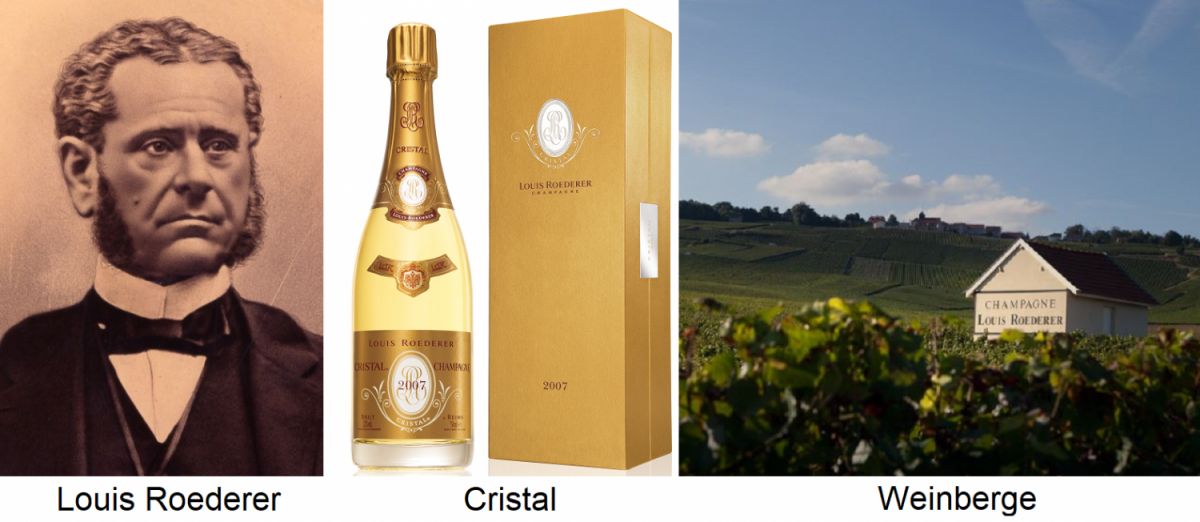The origin of the Champagne House in Reims lies in the company Dubois Père et Fils, which is first mentioned in 1760. Later, this company was owned by Nicolas-Henri Schreider, who is considered the official founder in 1776. The latter hired his nephew Louis Roederer (1809-1870) in 1827. After Schreider's death in 1833, the heir renamed the company Roederer, which is still used today. He succeeded in opening up new markets in America and England, as well as winning over the Russian Tsar Alexander I (1777-1825) as a buyer of his champagne. In 1870, Louis Roederer II. (1846-1880) took over the management of the company, which had expanded considerably in the meantime.

The Russian court remained loyal to the company even under Tsar Alexander II. (1818-1881), the Russian court remained loyal to Roederer champagne. An extremely sweet champagne was produced for Alexander, which was particularly appreciated at court and in aristocratic circles. Fearing the frequent assassinations at the time and inspired by a champagne bottle by Mercier, the Tsar's cellar master demanded transparent bottles so that a poisoned champagne could be quickly visually identified. Roederer complied with this special request and the champagne was first delivered to Russia in 1876. The brand known as "Cristal" was filled in bottles made of clear crystal glass with a flat bottom. Allegedly, the flat bottom was required in order to prevent a small explosive device from being placed in the indentation of the bottom of the bottle. This brand, which still exists today, is still bottled in transparent bottles without an indentation at the bottom, just like all other products.
After Louis Roederer's death in 1880, his sister Léonie Orly took over the business, which was continued by her sons Léon Orly and Louis-Victor Orly, who added the suffix Roederer to their names. At this time, 2.5 million bottles of champagne were already produced annually. After the death of Léon Orly-Roederer in 1932, his widow Camille Orly-Roederer took over the management for the next 42 years. She opened up new markets and increased the vineyard holdings. The company's own vineyards in Champagne cover 240 hectares of vines in the three areas of Montagne de Reims, Vallée de la Marne and Côte des Blancs, with Pinot Noir as the main grape. They are cultivated according to the rules of organic (140 ha) and biodynamic viticulture (100 ha). This area covers two thirds of the demand; the rest is supplied by contract winegrowers.
The reserve wines are stored for a very long time in foudres (large Limousin oak barrels with a volume of 4,000 to 5,000 litres) and around 250 stainless steel tanks with a volume of almost 10,000 litres. The oak barrels are used for up to 60 years. Special attention is paid to the dosage. The vintageless champagnes are stored on the yeast for three to four years, the vintage champagnes (Millésime) for five to six years. After disgorgement, the bottles are stored for another six months before being marketed. The standard version is called "Brut Premier" and is blended from around 65% Pinot Noir, 30% Chardonnay and 5% Pinot Meunier. It contains around 20% reserve wines. It is produced with four years of yeast age ing. The vintage champagne "Brut Vintage Milléssimé" is blended from about two-thirds Pinot Noir and one-third Chardonnay and is aged on the yeast for at least five to six years. There is also a rosé version with around 80% Pinot Noir.
Two products are among the Cuvée de Prestiges, i.e. the absolute best Champagnes of the house. After the Second World War, the famous "Cristal" was reintroduced. It is a vintage champagne blended from 50 to 60% Pinot Noir and 40 to 50% Chardonnay. Only the choicest wines from their own Grand Crus are used. The transparent bottles are wrapped in yellow cellophane, which protects them from ultraviolet radiation. There is also a rosé version, first produced in 1974, made from 70% Pinot Noir and 30% Chardonnay, which is one of the very best rosé champagnes.
In 1993, the majority of the champagne company Deutz was taken over. Other holdings or participations are the wine estates Château de Pez, Château Haut-Beauséjour and Château Pichon-Longueville Comtesse in Bordeaux, as well as the wine trading house Maison Descaves; the trading house Delas in the Rhône Valley; the Portuguese port wine house Ramos Pinto in the Douro; as well as the Roederer Estate in California's Anderson Valley. The company is still family-owned and run by a descendant.
Louis Roederer: Par Roederer - Travail personnel, CC BY-SA 3.0, Link
Cristal: Par Ecolin51100 - Travail personnel, CC BY-SA 4.0, Link
Weinberg: Par Ecolin51100 - Travail personnel , CC BY-SA 4.0, Link
Voices of our members

There is a vast number of sources on the web where one can acquire knowledge about wine. But none has the scope, timeliness and accuracy of the information in the encyclopaedia at wein.plus. I use it regularly and rely on it.
Sigi Hiss
freier Autor und Weinberater (Fine, Vinum u.a.), Bad Krozingen